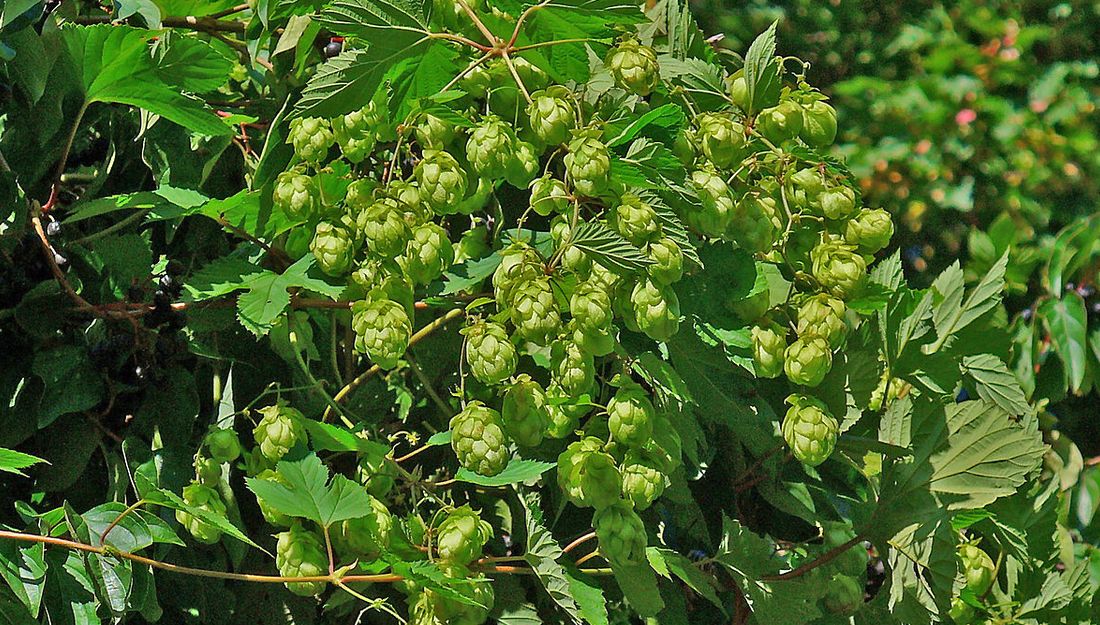Hops, the Brewing Sister of Cannabis
In the verdant valleys of ancient Europe, where the rivers meandered through lush landscapes, a mysterious plant grew in abundance. Its vines twisted and turned, reaching for the sky, adorned with cone-like flowers that emitted a tempting aroma. This was Humulus lupulus, the hop plant, waiting to be discovered.

The Discovery of Lupulus
In a time long forgotten, when the world was still shrouded in mystery, the verdant valleys of ancient Europe were home to countless wonders. Among them was a small village, nestled by the river’s edge, where nature and humanity lived in harmonious balance.
Elara, a young herbalist with an insatiable curiosity, roamed the meadows and forests, seeking the secrets hidden within the plants. Her heart was a wellspring of wisdom, and her hands were guided by an ancient intuition that transcended mere knowledge.
One day, as the sun kissed the horizon, casting a golden glow over the land, Elara stumbled upon a vine unlike any she had seen before. Its leaves were palmately lobed, its flowers unisexual, and its scent intoxicating. It was Humulus lupulus, the hop plant, waiting to reveal its mysteries.
Days turned into weeks as Elara immersed herself in the study of the hop plant. She would sit by the riverside, sketching its form, inhaling its aroma, and listening to the whispers of the wind as it danced through the vines.
The hop plant was more than just a botanical curiosity; it was a living entity with a soul. It spoke to Elara in dreams, guiding her hands as she crafted potions and salves. The villagers, once sceptical, began to seek her wisdom, for her brews brought relief to the weary and solace to the troubled.
Word of Elara’s discoveries reached far and wide, even to the grand halls of Rome. Scholars and physicians were intrigued by the hop plant’s sedative properties. The Romans, known for their lavish feasts and hedonistic pursuits, saw in the hop plant a means to calm the mind and induce restful sleep.
Emperors and nobles would rest their heads on cushions filled with hop leaves, believing in their power to ward off nightmares and bring peaceful dreams. The hop plant became a symbol of tranquility, its essence captured in poems and songs that echoed through the marble corridors of Rome.
As the sands of time flowed, the hop plant’s fame spread across the continents. It became a beacon for herbalists, healers, and seekers of truth. Its story was etched in manuscripts, preserved in monasteries, and passed down through generations.
The discovery of the hop plant was not merely a moment in history; it was a journey of the human spirit, a testament to the eternal quest for understanding and connection. It was a reminder that nature’s gifts are endless, waiting to be uncovered by those with the courage to look beyond the surface.
Elara’s legacy lived on, her name synonymous with wisdom and compassion. The hop plant continued to thrive, its vines reaching for the sky, its secrets still whispering to those willing to listen.

The discovery of the hop plant, Humulus lupulus, cannot be attributed to a specific individual, this is just a tale to illustrate it. Hops have been known and used for various purposes for centuries, and their utilization can be traced back to ancient civilizations.
The narrative provided earlier is a fictionalized account, and the character of Elara is a fictional creation to represent the ancient connection between humans and the hop plant. In reality, the discovery and utilization of hops would have been a gradual process, evolving over time and across different cultures.
The Historical Curiosities
As the dark ages gave way to the medieval era, the world was in a state of flux. Kingdoms rose and fell, and new ideas began to take root. Among the bustling towns and thriving markets, a craft was emerging that would become a cornerstone of culture: brewing.
Alehouses and taverns were gathering places, where stories were shared, and bonds were forged. But the art of brewing was still in its infancy, and consistency was a constant challenge. Beers were often spoiled, their aromas unpredictable.
Then came the hop plant, a gift from nature that would transform the world of brewing. Its preservative qualities were a revelation, and its unique taste added a new dimension to the brewer’s palette. The hop plant was no longer just a healer’s ally; it was a brewmaster’s muse.
In the secluded monasteries of Europe, monks dedicated their lives to faith, knowledge, and craftsmanship. Among their many pursuits was the brewing of beer, a practice that was both a spiritual endeavor and a means of sustenance.
The monks were meticulous in their craft, and the hop plant became a central ingredient in their brews. They cultivated hop gardens, studying the plant’s growth and experimenting with different varieties. The monasteries became centers of brewing innovation, and the hop plant was at the heart of it all.
Across the English Channel, the hop plant found a new home in the fertile soils of Kent. The English embraced the hop plant with a passion, and hop gardens became a symbol of prosperity and pride.
Farmers and botanists worked hand in hand, selecting and breeding hop varieties that would become renowned for their quality and flavour. The English ales, infused with the essence of hops, became a national treasure, and the hop plant was celebrated in festivals and fairs.
As the centuries rolled on, the hop plant’s fame spread across the globe. From the beer halls of Germany to the craft breweries of America, the hop plant became a universal symbol of brewing excellence.
Its story was no longer confined to a single village or empire; it was a global narrative, a testament to human creativity and collaboration. The hop plant had transcended its humble origins, becoming a cultural icon that united people across borders and generations.
The Modern Uses of the brewing sister of Cannabis
In the laboratories and research centres of the modern world, the hop plant found a new realm of exploration. Scientists, fascinated by its complex chemistry and diverse properties, began to unlock its potential in ways that transcended traditional brewing.
Pharmaceutical companies saw in the hop plant a source of natural compounds that could be harnessed for medicinal purposes. Its sedative effects were refined into treatments for anxiety and insomnia, and its anti-inflammatory properties were utilized in pain relief.
The hop plant was no longer just a brewer’s ingredient; it was a subject of scientific inquiry, a puzzle to be solved, and a treasure trove of possibilities.
In the bustling kitchens of gourmet restaurants and the homes of culinary enthusiasts, the hop plant embarked on a gastronomic adventure. Chefs began to experiment with its unique spirits, incorporating hops into sauces, salads, and even desserts.
The hop plant’s culinary applications were as diverse as its taste profile. From hop-infused oils to delicate hop-flavored pastries, it became a symbol of culinary creativity and innovation.
Food lovers and critics alike were captivated by the hop plant’s ability to transform ordinary dishes into extraordinary experiences. It was a taste of nature, a reminder of the earth’s bounty, and a celebration of human ingenuity.
In the garages and small breweries of passionate beer enthusiasts, the hop plant ignited a revolution. The craft beer movement, driven by a desire to reconnect with the roots of brewing, embraced the hop plant with fervor.
Brewers experimented with different hop varieties, creating bold and distinctive beers that challenged conventional tastes. The hop plant was not just an ingredient; it was a statement, a declaration of individuality and craftsmanship. The craft beer revolution spread like wildfire, and the hop plant was at the forefront, inspiring a new generation of brewers and beer lovers.
In the fields and gardens where the hop plant grew, a new understanding of its ecological significance began to emerge. Farmers and environmentalists recognized its role in promoting biodiversity and its potential in sustainable agriculture.
The hop plant’s ability to thrive in various climates and its symbiotic relationships with insects and fungi made it a valuable asset in ecological restoration projects.
It was a reminder that nature’s gifts were not just resources to be exploited but living entities to be nurtured and respected. The hop plant’s story was now intertwined with the global quest for environmental harmony and sustainability.
Description and Characteristics
Humulus lupulus is a dioecious, climbing plant with yellowish rhizomes from which stems emerge, reaching up to 6 or 10 meters in length. The leaves are opposite, palmately lobed, and the flowers are unisexual, appearing in inflorescences. The male flowers are in branched panicles, while the female flowers form cone-like inflorescences. The fruit is an achene, globular, and covered with numerous glands that secrete aromatic substances.
Habitat and Ecology
This plant grows in moist and cool areas, from 100 to 1000 meters above sea level. It is commonly found in sotos, alisedas, and other damp regions. It is a characteristic plant of the Querco-Fagetea class, thriving in mesophytic or hygrophilous forests.
Distribution
Humulus lupulus is found in temperate and cold regions of the northern hemisphere. In the Iberian Peninsula, it is more frequent in the northern half.
Protection and Threats
The species is categorized as “Least Concern” (LC) by the IUCN in Spain, with a stable population trend.
Medicinal and Nutritional Benefits
The plant has a long history in natural medicine, used as a sedative, tonic, and calming agent. It stimulates digestion and gastric secretions. The female inflorescences are used for various therapeutic purposes, including treating burns, fever, insomnia, and rheumatism. The seeds contain gamma-linolenic acid, an essential fatty acid. Young leaves and shoots are edible and can be used in salads, and the dried female inflorescences are used to flavour beer.
- Ecological Importance: The wide range of habitats where Humulus lupulus grows and its association with various fungi and insects highlights its ecological significance. How can this plant be utilized to enhance biodiversity in managed landscapes?
- Medicinal Potential: With its diverse medicinal properties, ranging from sedative to antibacterial effects, what research has been conducted to explore the pharmaceutical applications of this plant? Could it be a key ingredient in future medications?
- Culinary and Brewing Uses: The use of hops in beer brewing is well-known, but its culinary applications, such as in salads and teas, are less explored. How can chefs and food enthusiasts leverage the unique flavors and nutritional benefits of this plant in innovative culinary creations?
Medicinal Properties of Hops
Hops have been traditionally used as a calming medicinal plant. The Romans were known to use hops for their tranquillizing effects, and it was common to sleep on cushions filled with hops leaves. Modern studies have identified over 20 compounds in hops that have sedative effects.
Internal Use of Lupulum
- Nervous System Problems: Hops are used to treat nervous disorders, utilizing their sedative properties to calm the nerves. Components like stigmasterol, isovaleric acid, limonene, and eugenol are among the most important tranquilizing elements.
- Remedies for Anxiety, Insomnia, and Nervousness: Infusions made from female hop flowers can help with anxiety, insomnia, and general nervousness.
- Pain Relief: Hops can help with tension headaches, palpitations, muscle stiffness, and stomach issues, often related to psychological factors.
- Menopause Treatment: Hops are rich in phytoestrogens, which can reduce menopause symptoms like hot flashes and irritability.
External Use of Hops
- Skin Conditions: Hops have properties that are suitable for treating skin conditions like eczema, dermatitis, and ulcers.
- Rheumatic Pains: They can also reduce pain and inflammation in joints affected by rheumatic diseases.
Other Uses of Hops
- Food: Hops are edible and can be used in salads, soups, or as vegetables.
- Beer Flavoring: Industrially, hops are used in beer manufacturing for their unique flavor and preservation qualities.
- Perfumes and Lupulin: Hops are used in perfumery and the production of lupulin, a concentrated yellow powder with therapeutic properties.
Safety and Contraindications
Hops are generally safe to consume but may cause allergic reactions in sensitive individuals. They are not recommended for people with depression, pregnancy, or cancer.
Insights and Questions about Lupulum
How have traditional uses of hops influenced modern medicinal practices?
The connection between ancient and modern uses. The Romans’ use of hops for sleep and relaxation has been validated by modern studies, showing a fascinating link between ancient wisdom and contemporary science.
What makes hops such a versatile plant?
From calming the nerves to flavouring beer. Its wide range of applications in medicine, food and industry reflects the complexity and richness of this unique plant. This is possible thanks to all the compounds that it contains.
what specific conditions or sensitivities may require caution when using hops?
Although Hops are generally considered safe. Understanding the contraindications and possible allergic reactions is essential for safe and effective use. It is not recommended for use by people with depression, pregnancy or cancer.
This information provides a comprehensive overview of hops, highlighting its history, traditional and modern applications, versatility, and safety considerations. I hope you really like it, this content about Lupulum, if you did so, please share it with your friends and family and follow us in our newsletter and social networks, thank you and see you soon!
Founder of Experiencia Natural, creative and entrepreneur, designer, master in grower and marketing. For a normalization of all plants and substances, giving priority to patients and users.











